The Lifepo4 Voltage Chart 12V 24V 48V and LiFePO4 Voltage State of Charge Table provides a comprehensive overview of voltage levels corresponding to various states of charge for LiFePO4 Battery. Understanding these voltage levels is crucial for monitoring and managing battery performance. By referring to this table, users can accurately assess the state of charge of their LiFePO4 batteries and optimize their usage accordingly.
What is LiFePO4?
LiFePO4 batteries, or lithium iron phosphate batteries, are a type of lithium-ion battery composed of lithium ions combined with FePO4. They are similar in appearance, size, and weight to lead-acid batteries, but differ significantly in electrical performance and safety. Compared to other types of lithium-ion batteries, LiFePO4 batteries offer higher discharge power, lower energy density, long-term stability, and higher charging rates. These advantages make them the preferred battery type for electric vehicles, boats, drones, and power tools. Additionally, they are used in solar energy storage systems and backup power sources due to their long charging cycle life and superior stability at high temperatures.
Lifepo4 Voltage State of Charge Table
Lifepo4 Voltage State of Charge Table
| Charge state (SOC) |
3.2V Battery voltage (V) |
12V Battery voltage (V) |
36V Battery voltage (V) |
| 100 % Aufladung |
3.65V |
14.6V |
43.8V |
| 100 % Ruhe |
3.4V |
13.6V |
40.8V |
| 90% |
3.35V |
13.4V |
40.2 |
| 80% |
3.32V |
13.28V |
39.84V |
| 70% |
3.3V |
13.2V |
39.6V |
| 60% |
3.27V |
13.08V |
39.24V |
| 50% |
3.26V |
13.04V |
39.12V |
| 40% |
3.25V |
13V |
39V |
| 30% |
3.22V |
12.88V |
38.64V |
| 20% |
3.2V |
12.8V |
38.4 |
| 10% |
3V |
12V |
36V |
| 0% |
2.5V |
10V |
30V |
Lifepo4 Voltage State of Charge Table 24V
| Charge state (SOC) |
24V Battery voltage (V) |
| 100 % Aufladung |
29.2V |
| 100 % Ruhe |
27.2V |
| 90% |
26.8V |
| 80% |
26.56V |
| 70% |
26.4V |
| 60% |
26.16V |
| 50% |
26.08V |
| 40% |
26V |
| 30% |
25.76V |
| 20% |
25.6V |
| 10% |
24V |
| 0% |
20V |
Lifepo4 Voltage State of Charge Table 48V
| Charge state (SOC) |
48V Battery voltage (V) |
| 100 % Aufladung |
58.4V |
| 100 % Ruhe |
58.4V |
| 90% |
53.6 |
| 80% |
53.12V |
| 70% |
52.8V |
| 60% |
52.32V |
| 50% |
52.16 |
| 40% |
52V |
| 30% |
51.52V |
| 20% |
51.2V |
| 10% |
48V |
| 0% |
40V |
Lifepo4 Voltage State of Charge Table 72V
| Charge state (SOC) |
Battery voltage (V) |
| 0% |
60V – 63V |
| 10% |
63V – 65V |
| 20% |
65V – 67V |
| 30% |
67V – 69V |
| 40% |
69V – 71V |
| 50% |
71V – 73V |
| 60% |
73V – 75V |
| 70% |
75V – 77V |
| 80% |
77V – 79V |
| 90% |
79V – 81V |
| 100% |
81V – 83V |
LiFePO4 Voltage Chart (3.2V, 12V, 24V, 48V)
3.2V Lifepo4 Voltage Chart
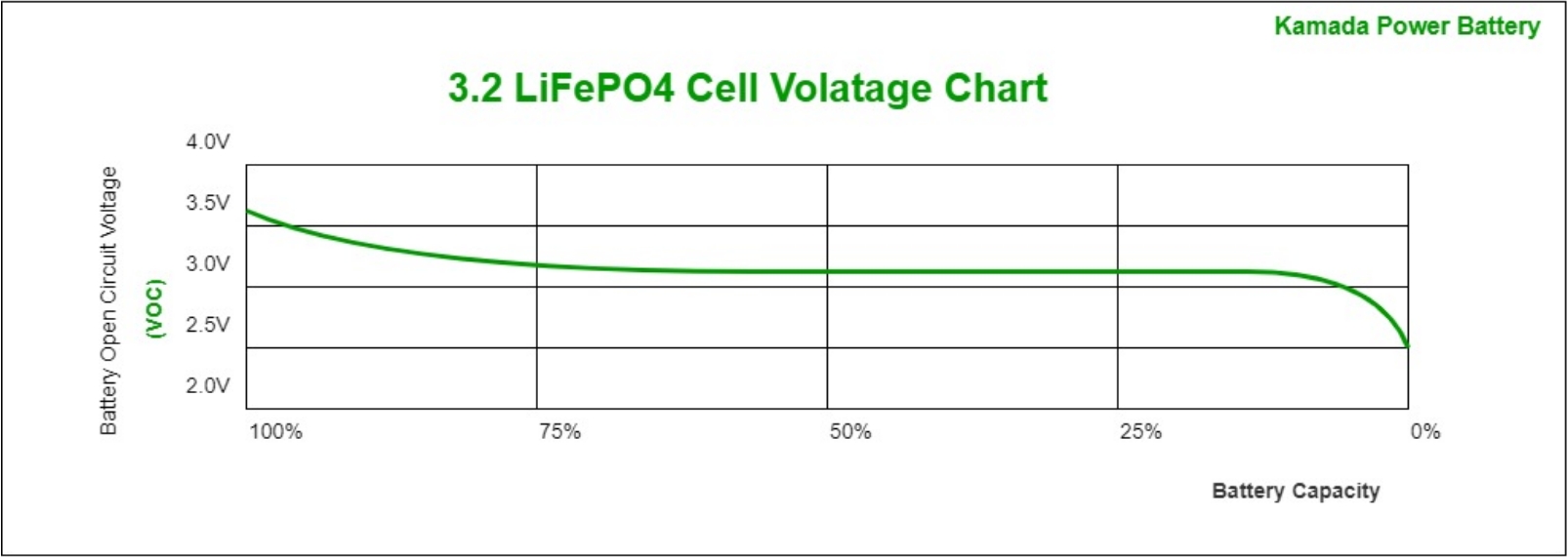
12V Lifepo4 Voltage Chart
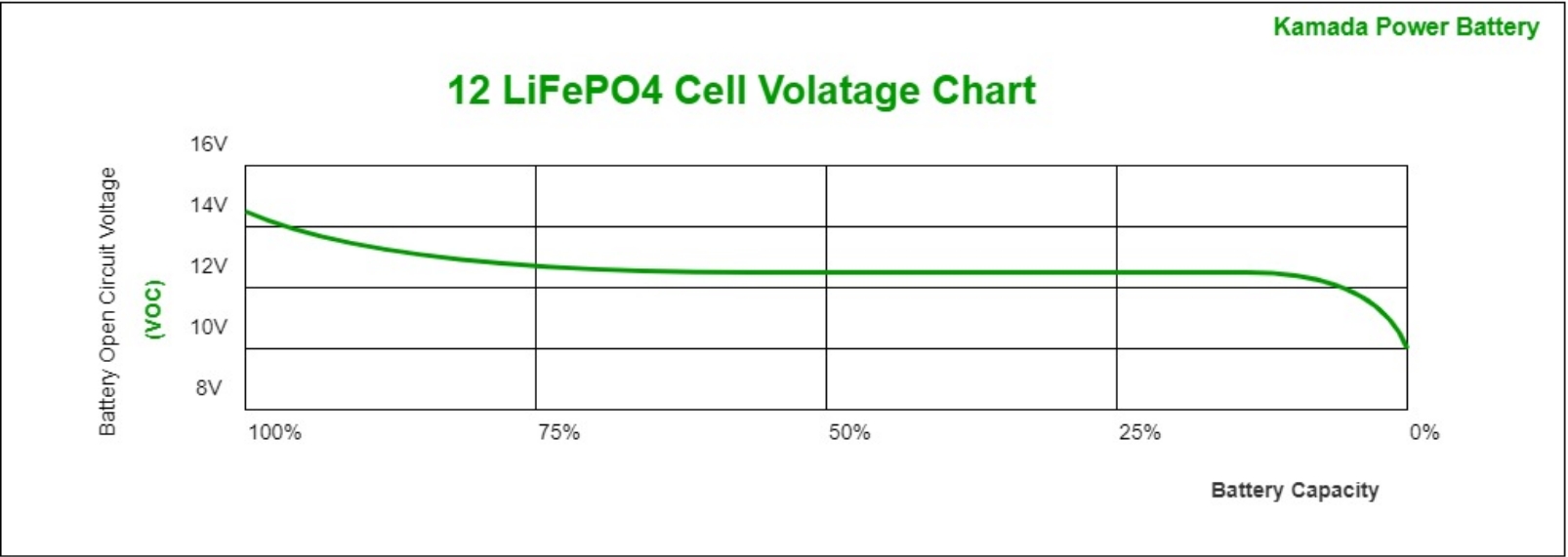
24V Lifepo4 Voltage Chart
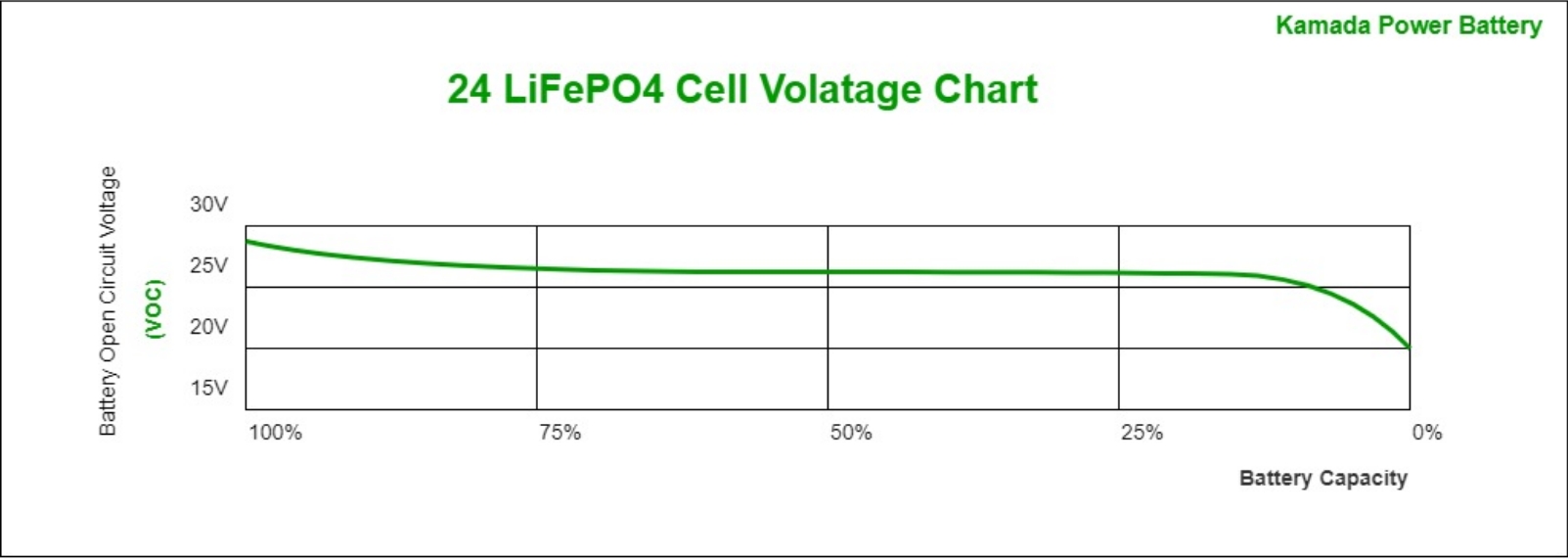
36V Lifepo4 Voltage Chart
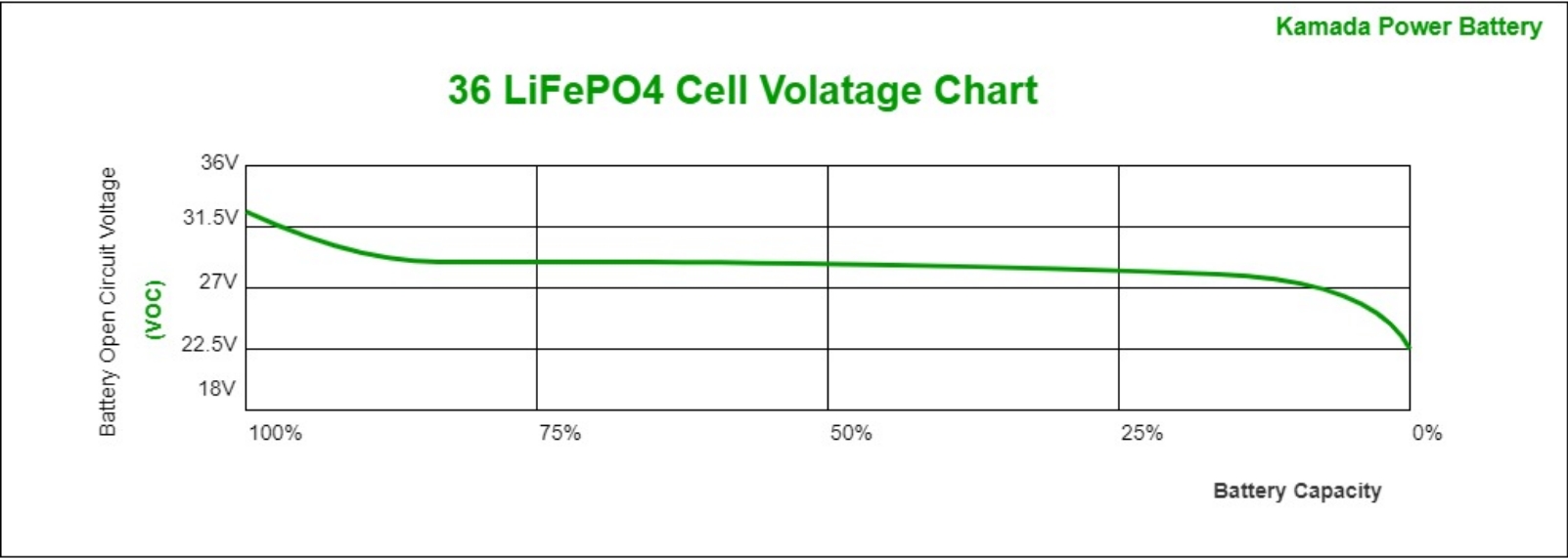
48V Lifepo4 Voltage Chart
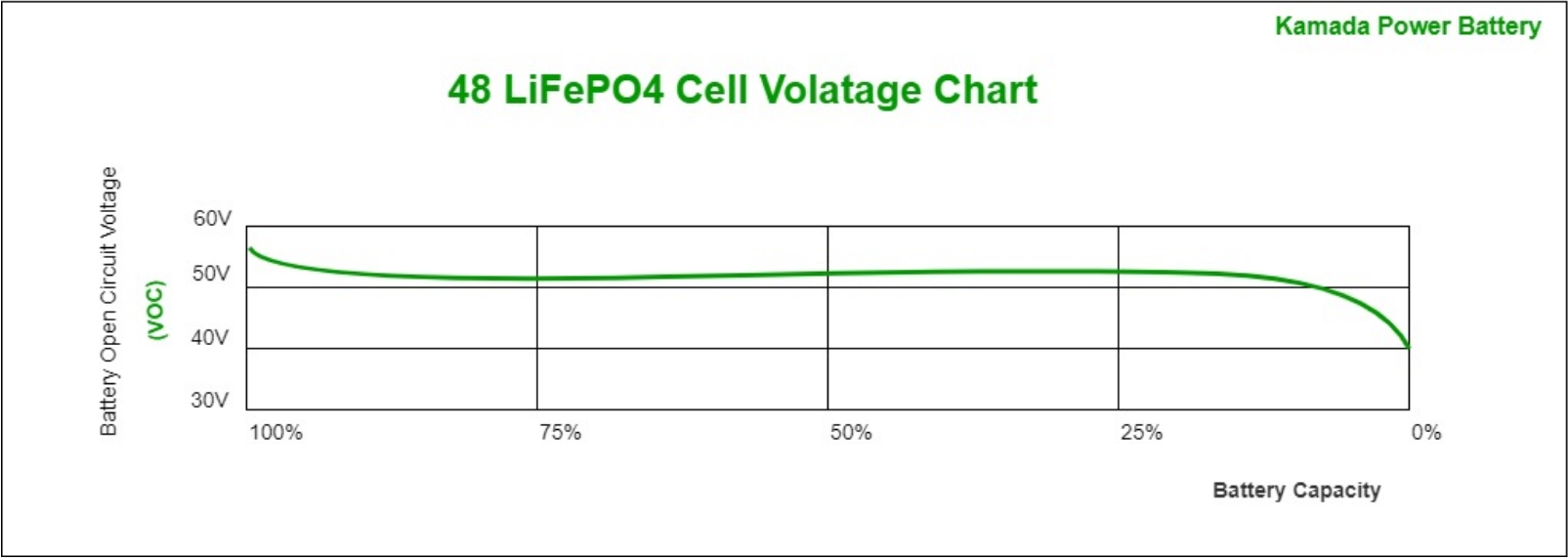
LiFePO4 Battery Charging & Discharging
The State of Charge (SoC) and LiFePO4 battery voltage chart provides a comprehensive understanding of how the voltage of a LiFePO4 battery varies with its State of Charge. SoC represents the percentage of available energy stored in the battery relative to its maximum capacity. Understanding this relationship is crucial for monitoring battery performance and ensuring optimal operation in various applications.
| State of Charge (SoC) |
LiFePO4 Battery Voltage (V) |
| 0% |
2.5V – 3.0V |
| 10% |
3.0V – 3.2V |
| 20% |
3.2V – 3.4V |
| 30% |
3.4V – 3.6V |
| 40% |
3.6V – 3.8V |
| 50% |
3.8V – 4.0V |
| 60% |
4.0V – 4.2V |
| 70% |
4.2V – 4.4V |
| 80% |
4.4V – 4.6V |
| 90% |
4.6V – 4.8V |
| 100% |
4.8V – 5.0V |
Determining a battery’s State of Charge (SoC) can be achieved through various methods, including voltage assessment, coulomb counting, and specific gravity analysis.
Voltage Assessment: Higher battery voltage typically indicates a fuller battery. For accurate readings, it’s crucial to let the battery rest for at least four hours before measurement. Some manufacturers recommend even longer resting periods, up to 24 hours, to ensure precise results.
Counting Coulombs: This method measures the flow of current in and out of the battery, quantified in ampere-seconds (As). By tracking the battery’s charging and discharging rates, coulomb counting provides a precise assessment of SoC.
Specific Gravity Analysis: SoC measurement using specific gravity requires a hydrometer. This device monitors liquid density based on buoyancy, offering insights into the battery’s state.
To prolong the LiFePO4 battery’s lifespan, it’s essential to charge it properly. Each battery type has a specific voltage threshold for achieving maximum performance and enhancing battery health. Referencing the SoC chart can guide recharging efforts. For instance, a 24V battery’s 90% charge level corresponds to approximately 26.8V.
The state of charge curve illustrates how a 1-cell battery’s voltage varies over charging time. This curve provides valuable insights into the battery’s charging behavior, aiding in optimizing charging strategies for prolonged battery life.
Lifepo4 Battery State of charge Curve @ 1C 25C
Voltage: A higher nominal voltage indicates a more charged battery state. For instance, if a LiFePO4 battery with a nominal voltage of 3.2V reaches a voltage of 3.65V, it indicates a highly charged battery.
Coulomb Counter: This device measures the flow of current into and out of the battery, quantified in ampere-seconds (As), to gauge the battery’s charging and discharging rate.
Specific Gravity: To determine the State of Charge (SoC), a hydrometer is required. It assesses liquid density based on buoyancy.
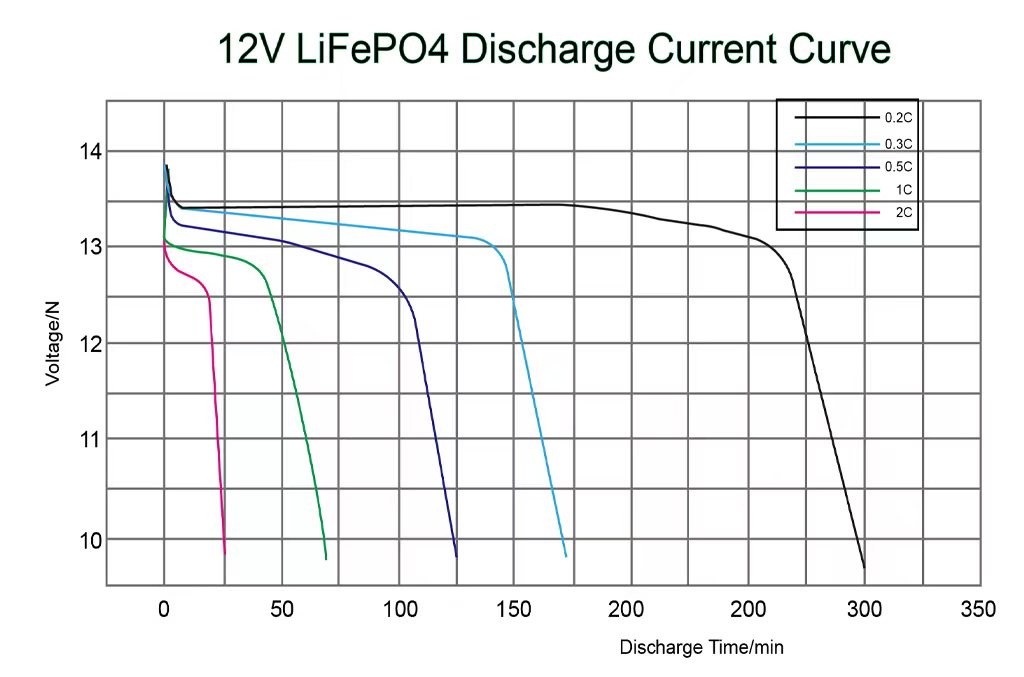
LiFePO4 Battery Charging Parameters
LiFePO4 battery charging involves various voltage parameters, including charging, float, maximum/minimum, and nominal voltages. Below is a table detailing these charging parameters across different voltage levels: 3.2V, 12V, 24V,48V,72V
| Voltage (V) |
Charging Voltage Range |
Float Voltage Range |
Maximum Voltage |
Minimum Voltage |
Nominal Voltage |
| 3.2V |
3.6V – 3.8V |
3.4V – 3.6V |
4.0V |
2.5V |
3.2V |
| 12V |
14.4V – 14.6V |
13.6V – 13.8V |
15.0V |
10.0V |
12V |
| 24V |
28.8V – 29.2V |
27.2V – 27.6V |
30.0V |
20.0V |
24V |
| 48V |
57.6V – 58.4V |
54.4V – 55.2V |
60.0V |
40.0V |
48V |
| 72V |
86.4V – 87.6V |
81.6V – 82.8V |
90.0V |
60.0V |
72V |
Lifepo4 Battery Bulk Float Equalize Voltage
The three primary voltage types commonly encountered are bulk, float, and equalize.
Bulk Voltage: This voltage level facilitates rapid battery charging, typically observed during the initial charging phase when the battery is completely discharged. For a 12-volt LiFePO4 battery, the bulk voltage is 14.6V.
Float Voltage: Operating at a lower level than bulk voltage, this voltage is sustained once the battery reaches full charge. For a 12-volt LiFePO4 battery, the float voltage is 13.5V.
Equalize Voltage: Equalization is a crucial process for maintaining battery capacity, requiring periodic execution. The equalize voltage for a 12-volt LiFePO4 battery is 14.6V.、
| Voltage (V) |
3.2V |
12V |
24V |
48V |
72V |
| Bulk |
3.65 |
14.6 |
29.2 |
58.4 |
87.6 |
| Float |
3.375 |
13.5 |
27.0 |
54.0 |
81.0 |
| Equalize |
3.65 |
14.6 |
29.2 |
58.4 |
87.6 |
12V Lifepo4 Battery Discharge Current Curve 0.2C 0.3C 0.5C 1C 2C
Battery discharge occurs when power is drawn from the battery to charge appliances. The discharge curve graphically illustrates the correlation between voltage and discharge time.Below, you’ll find the discharge curve for a 12V LiFePO4 battery at various discharge rates.
Factors Affecting Battery State of Charge
| Factor |
Description |
Source |
| Battery Temperature |
Battery temperature is one of the important factors affecting SOC. High temperatures accelerate internal chemical reactions in the battery, leading to increased battery capacity loss and reduced charging efficiency. |
U.S. Department of Energy |
| Battery Material |
Different battery materials have different chemical properties and internal structures, which affect charging and discharging characteristics, and thus SOC. |
Battery University |
| Battery Application |
Batteries undergo different charging and discharging modes in different application scenarios and uses, directly affecting their SOC levels. For example, electric vehicles and energy storage systems have different battery usage patterns, leading to different SOC levels. |
Battery University |
| Battery Maintenance |
Improper maintenance leads to decreased battery capacity and unstable SOC. Typical incorrect maintenance includes improper charging, prolonged periods of inactivity, and irregular maintenance checks. |
U.S. Department of Energy |
Capacity Range of Lithium Iron Phosphate(Lifepo4) Batteries
| Battery Capacity (Ah) |
Typical Applications |
Additional Details |
| 10ah |
Portable electronics, small-scale devices |
Suitable for devices such as portable chargers, LED flashlights, and small electronic gadgets. |
| 20ah |
Electric bikes, security devices |
Ideal for powering electric bicycles, security cameras, and small-scale renewable energy systems. |
| 50ah |
Solar energy storage systems, small appliances |
Commonly used in off-grid solar systems, backup power for home appliances like refrigerators, and small-scale renewable energy projects. |
| 100ah |
RV battery banks, marine batteries, backup power for home appliances |
Suitable for powering recreational vehicles (RVs), boats, and providing backup power for essential home appliances during power outages or in off-grid locations. |
| 150ah |
Energy storage systems for small homes or cabins, medium-sized backup power systems |
Designed for use in small off-grid homes or cabins, as well as medium-sized backup power systems for remote locations or as a secondary power source for residential properties. |
| 200ah |
Large-scale energy storage systems, electric vehicles, backup power for commercial buildings or facilities |
Ideal for large-scale energy storage projects, powering electric vehicles (EVs), and providing backup power for commercial buildings, data centers, or critical facilities. |
The five key factors influencing the lifespan of LiFePO4 batteries.
| Factor |
Description |
Data Source |
| Overcharging/Overdischarging |
Overcharging or overdischarging can damage LiFePO4 batteries, leading to capacity degradation and reduced lifespan. Overcharging may cause changes in the solution composition in the electrolyte, resulting in gas and heat generation, leading to battery swelling and internal damage. |
Battery University |
| Charge/Discharge Cycle Count |
Frequent charge/discharge cycles accelerate battery aging, reducing its lifespan. |
U.S. Department of Energy |
| Temperature |
High temperatures accelerate battery aging, reducing its lifespan. At low temperatures, battery performance is also affected, resulting in decreased battery capacity. |
Battery University; U.S. Department of Energy |
| Charging Rate |
Excessive charging rates may cause the battery to overheat, damaging the electrolyte and reducing battery lifespan. |
Battery University; U.S. Department of Energy |
| Depth of Discharge |
Excessive depth of discharge has a detrimental effect on LiFePO4 batteries, reducing their cycle life. |
Battery University |
Final Thoughts
While LiFePO4 batteries may not be the most affordable option initially, they offer the best long-term value. Utilizing the LiFePO4 voltage chart allows for easy monitoring of the battery’s State of Charge (SoC).